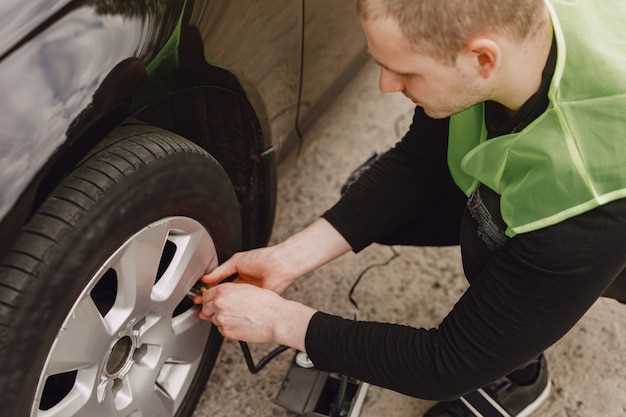
The significance of maintaining optimal tire pressure cannot be overstated, especially in high-performance track environments. Accurate tire pressure directly influences the handling, grip, and overall performance of a vehicle. As drivers push their machines to the limit, the need for precise monitoring becomes critical. This is where tire pressure monitoring systems, equipped with advanced sensors, play a pivotal role.
Tire pressure monitors provide real-time data, allowing drivers to make immediate adjustments to their tire pressure as conditions change on the track. These sensors continuously assess the tire’s inflation levels, ensuring that any deviations from the optimal range are promptly identified. This proactive approach not only enhances safety but also maximizes performance, enabling drivers to maintain their competitive edge.
Utilizing tire pressure monitors equipped with reliable sensors leads to improved consistency in lap times. Properly inflated tires ensure better traction and improved cornering stability, critical factors that can mean the difference between winning and losing in a competitive setting. Understanding the benefits of tire pressure monitors is essential for anyone serious about optimizing their track performance.
Impact of Accurate Tire Pressure on Handling and Stability
Maintaining accurate tire pressure is crucial for optimal track performance, as it directly influences the handling and stability of a vehicle. Tire pressure monitors equipped with sensors provide real-time data, ensuring that drivers can make immediate adjustments to maintain ideal pressure levels.
When the tire pressure is too low, the tire can flex more than designed, leading to increased deformation during cornering. This excessive flex adversely affects the vehicle’s responsiveness, resulting in sluggish handling and reduced feedback for the driver. In contrast, overinflated tires become stiffer, diminishing the contact patch with the track surface. This can cause premature wear and limit the tire’s ability to grip, leading to unpredictable behavior during acceleration and braking.
Accurate tire pressure ensures that the vehicle remains stable at high speeds. With the correct pressure, tires can conform to the track surface, enhancing grip and providing greater control in curves. This stability is particularly critical during competitive racing, where fractions of a second can determine outcomes. Moreover, consistent pressure readings from sensors allow teams to optimize tire performance throughout a race, adapting to changes in temperature and track conditions.
Overall, the impact of maintaining precise tire pressure cannot be overstated. It is fundamental to achieving the best possible handling characteristics, improving the confidence of the driver, and ultimately enhancing overall track performance.
Real-Time Monitoring: Enhancing Reaction Times During Races

Real-time monitoring of tire pressure plays a crucial role in improving reaction times during races. Advanced sensors integrated into the tire system provide continuous feedback on the pressure levels, allowing drivers to make informed decisions on-the-fly. Maintaining optimal tire pressure directly influences vehicle grip and handling, thereby affecting acceleration and braking response.
With accurate data from pressure sensors, drivers can detect any deviations from the ideal pressure range almost instantly. This timely information empowers them to adjust their driving strategy accordingly, optimizing tire performance throughout the race. When pressure levels are consistent, drivers can react more quickly to changes in track conditions, enhancing their overall agility and precision.
Furthermore, real-time updates assist in preemptive measures by alerting teams to potential tire issues before they escalate into hazards. Such proactive monitoring allows for immediate adjustments, minimizing downtime and maximizing effectiveness on the track. Thus, the integration of tire pressure monitors not only keeps performance levels high but also significantly boosts the driver’s ability to respond swiftly in competitive scenarios.
Preventing Tire Failure: The Role of Sensors in Track Safety

Tire failure can have catastrophic consequences on the track, not only affecting vehicle performance but also posing significant safety risks to drivers and spectators. The integration of pressure sensors into tire monitoring systems plays a crucial role in preventing these failures. By constantly measuring the tire pressure, these sensors provide real-time data that helps drivers maintain optimal conditions for their tires.
Maintaining the correct tire pressure is essential for ensuring proper tire integrity and performance. Under-inflated or over-inflated tires can lead to uneven wear, reduced traction, and increased heat generation, which ultimately heightens the risk of blowouts. Sensors that monitor pressure levels can alert drivers to any significant deviations from the recommended settings, allowing them to make necessary adjustments before a failure occurs.
Additionally, these sensors contribute to better vehicle handling on the track. Consistent pressure readings enable drivers to maintain a stable contact patch with the racing surface, enhancing grip and control, particularly during high-speed maneuvers. This not only improves lap times but also translates to a safer driving experience.
The data collected by pressure sensors can also aid in predictive maintenance. By analyzing trends in pressure fluctuations, teams can identify potential issues before they escalate, ensuring that tire replacements or repairs are executed proactively. This approach helps optimize tire performance over the course of a race event, thereby enhancing overall track safety.
Incorporating pressure sensors into tire management systems significantly mitigates the risks associated with tire failures. By providing critical information that allows for timely interventions, these devices play an indispensable role in promoting safety on the track, ensuring that drivers can focus their attention on performance without the looming threat of tire-related incidents.
